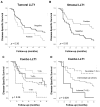Lectin-like Transcript-1 (LLT1) Expression in Oral Squamous Cell Carcinomas: Prognostic Significance and Relationship with the Tumor Immune Microenvironment
- PMID: 38673902
- PMCID: PMC11050533
- DOI: 10.3390/ijms25084314
Lectin-like Transcript-1 (LLT1) Expression in Oral Squamous Cell Carcinomas: Prognostic Significance and Relationship with the Tumor Immune Microenvironment
Abstract
Lectin-like transcript-1 (LLT1) expression is detected in different cancer types and is involved in immune evasion. The present study investigates the clinical relevance of tumoral and stromal LLT1 expression in oral squamous cell carcinoma (OSCC), and relationships with the immune infiltrate into the tumor immune microenvironment (TIME). Immunohistochemical analysis of LLT1 expression was performed in 124 OSCC specimens, together with PD-L1 expression and the infiltration of CD20+, CD4+, and CD8+ lymphocytes and CD68+ and CD163+-macrophages. Associations with clinicopathological variables, prognosis, and immune cell densities were further assessed. A total of 41 (33%) OSCC samples showed positive LLT1 staining in tumor cells and 55 (44%) positive LLT1 in tumor-infiltrating lymphocytes (TILs). Patients harboring tumor-intrinsic LLT1 expression exhibited poorer survival, suggesting an immunosuppressive role. Conversely, positive LLT1 expression in TILs was significantly associated with better disease-specific survival, and also an immune-active tumor microenvironment highly infiltrated by CD8+ T cells and M1/M2 macrophages. Furthermore, the combination of tumoral and stromal LLT1 was found to distinguish three prognostic categories (favorable, intermediate, and adverse; p = 0.029, Log-rank test). Together, these data demonstrate the prognostic relevance of tumoral and stromal LLT1 expression in OSCC, and its potential application to improve prognosis prediction and patient stratification.
Keywords: PD-L1; TILs; oral squamous cell carcinomaLLT1; prognosis.
Conflict of interest statement
The authors declare they have no conflicts of interest.
Figures


Similar articles
-
Cancer cell-specific PD-L1 expression is a predictor of poor outcome in patients with locally advanced oral cavity squamous cell carcinoma.J Immunother Cancer. 2024 Oct 2;12(10):e009617. doi: 10.1136/jitc-2024-009617. J Immunother Cancer. 2024. PMID: 39357980 Free PMC article.
-
Guanylate binding protein 5 is an immune-related biomarker of oral squamous cell carcinoma: A retrospective prognostic study with bioinformatic analysis.Cancer Med. 2024 Jul;13(13):e7431. doi: 10.1002/cam4.7431. Cancer Med. 2024. PMID: 38978333 Free PMC article.
-
PD-L1 expression correlates with tumor-infiltrating lymphocytes and better prognosis in patients with HPV-negative head and neck squamous cell carcinomas.Cancer Immunol Immunother. 2020 Oct;69(10):2089-2100. doi: 10.1007/s00262-020-02604-w. Epub 2020 May 24. Cancer Immunol Immunother. 2020. PMID: 32448984 Free PMC article.
-
The prognostic role of PD-L1 expression for survival in head and neck squamous cell carcinoma: A systematic review and meta-analysis.Oral Oncol. 2018 Nov;86:81-90. doi: 10.1016/j.oraloncology.2018.09.016. Epub 2018 Sep 17. Oral Oncol. 2018. PMID: 30409325
-
Prognostic and clinicopathological significance of PD-L1 overexpression in oral squamous cell carcinoma: A systematic review and comprehensive meta-analysis.Oral Oncol. 2020 Jul;106:104722. doi: 10.1016/j.oraloncology.2020.104722. Epub 2020 Apr 21. Oral Oncol. 2020. PMID: 32330687
Cited by
-
Altered Expression of NK Receptors in Racially/Ethnically Diverse and Risk-of-Relapse Pediatric Acute Lymphoblastic Leukemia Patients.Biomedicines. 2025 Jun 9;13(6):1412. doi: 10.3390/biomedicines13061412. Biomedicines. 2025. PMID: 40564131 Free PMC article.
-
The effect of postoperative adjuvant chemotherapy on survival outcomes in patients with early stage oral squamous cell carcinoma.Sci Rep. 2025 Jul 25;15(1):27157. doi: 10.1038/s41598-025-11565-y. Sci Rep. 2025. PMID: 40715317 Free PMC article.
References
MeSH terms
Substances
Grants and funding
LinkOut - more resources
Full Text Sources
Molecular Biology Databases
Research Materials

